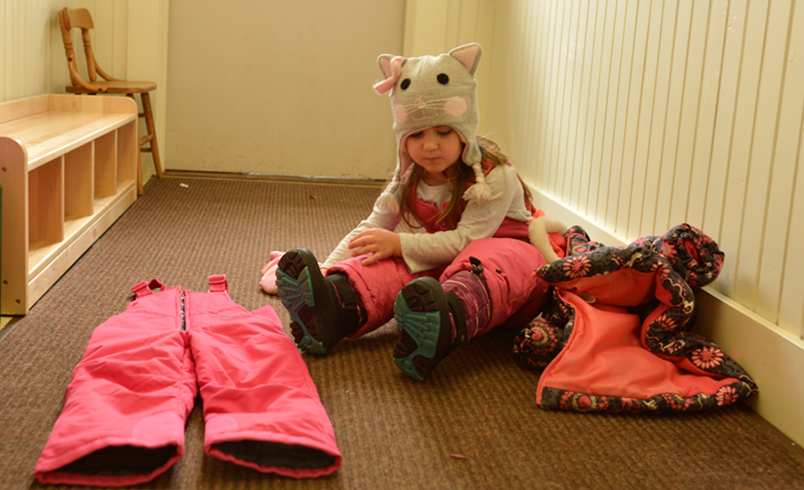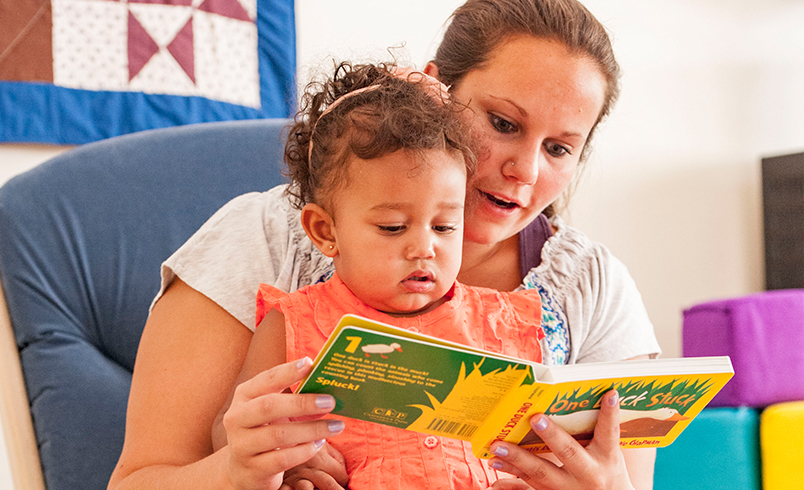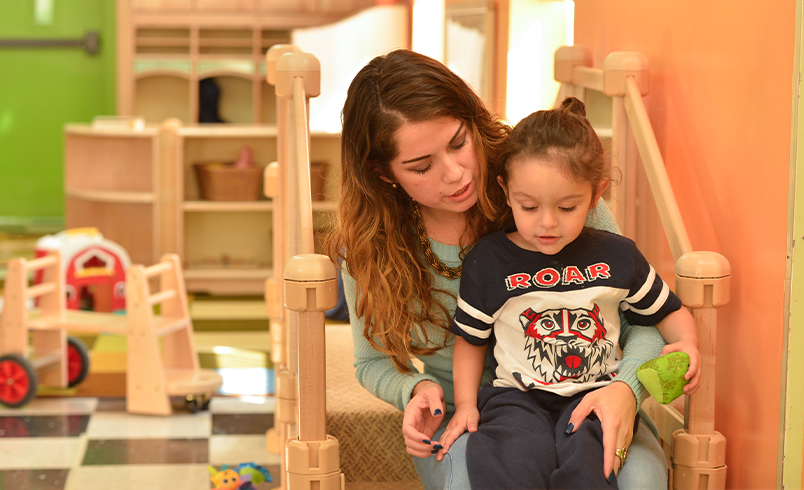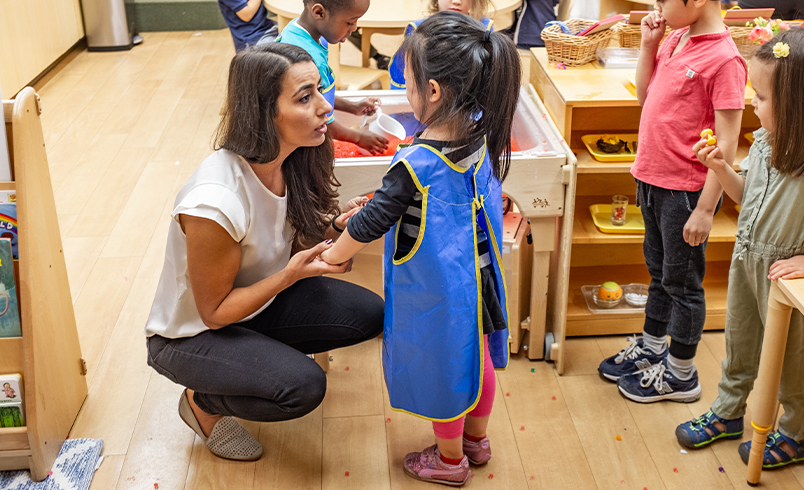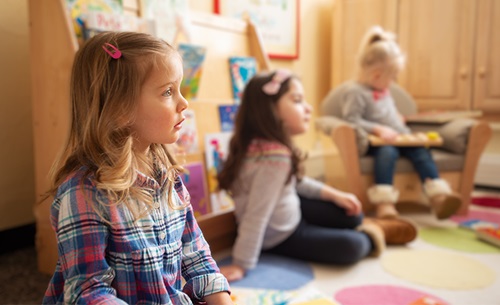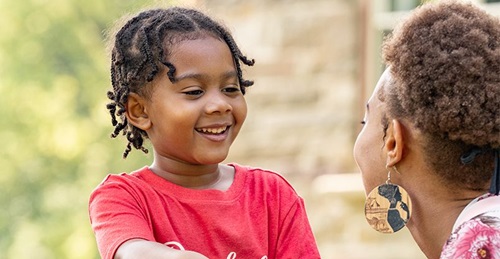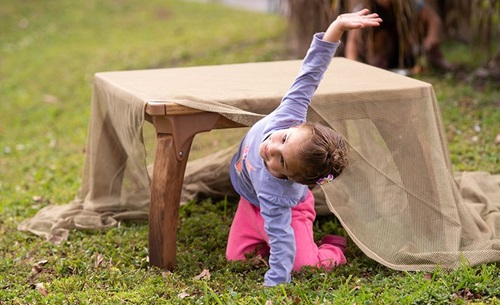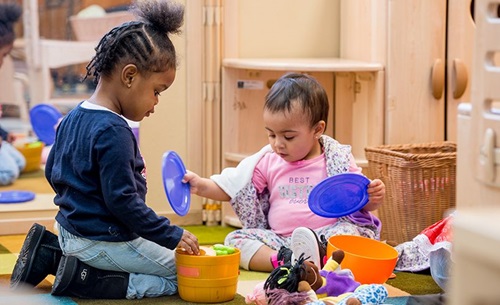Communicating Effectively with Children
Rethinking Transitions and Circle Times
| October 2023Throughout the day, children frequently shift between routines, activities, and classroom spaces. Early educators know that these transitions are often challenging for children. Common transition times in the preschool classroom include cleaning-up, moving between tasks, lining up for the bathroom, and going outside. Recent research has suggested upwards of 45% of children’s day includes non-learning time including transitions (Bustamante et al., 2018) and that longer transitions take away from learning time (Wilder et al. 2006). How can we guide children through the inevitable daily transitions?
It is important for teachers to learn a myriad of strategies for preventing and responding to challenging behaviors during these times. As teachers become more competent in effective strategies, they are likely to feel more confident in their role. Competence and confidence prepare teachers for effective intervention with the children, decreasing challenging behaviors.
Though formal research around best practices during circle time is sparse, early childhood educators can gain insight from some principles of early childhood development and developmental psychology to inform everyday practices. Most preschool classrooms include some version of circle time, an important opportunity for children to have positive peer interactions and interactive social skills in alternative learning settings. It’s important that teachers feel prepared for circle time in order to engage children in the activities.
For both circle time and transitions, children struggle the most when they are expected to wait. The fact is their ability to wait and sit still is not fully developed. Try to keep these times fun with songs and games, keeping children engaged, and changing the schedule if necessary to decrease wait times. In essence, the longer a group of children are expected to wait, the higher the likelihood of problem behavior.
Prevention is Key
It’s important for educators to focus on proactive, preventative measures rather than reactive tools to guide children through difficult behaviors and social insecurities.
Prevention Through Building Relationship: Pairing
The first, and most important preventative tool includes building positive relationships with every child, every day. In doing so, children will feel connected to both the teacher and a sense of belonging will encourage their positive engagement in classroom activities. “Pairing” is a behavioral tool whereby teachers focus on developing individual connection within the first 30-90 seconds of the day. During this timeframe teachers should refrain from giving instructions or asking questions, and solely focus on building relationships. They might say, “I’m happy to see you this morning”, “I love your new haircut”, or “I can’t wait to learn with you today”. Some children may prefer non-verbal connections like a side hug or special handshake. What matters most is that children feel the individual connection with the teacher during this initial re-engagement period (the first 30-90 seconds).
Effective Instruction Delivery
Without even realizing, many adults use sarcasm, metaphors, and indirect requests when communicating with children. However, communicating simply and clearly is fundamental towards effective communication.
Delivering Effective Instructions
There are six aspects to engaging in effective instructions; all of which are simple and logical but require practice to carry out consistently.
1. Make sure the child is attentive.
2. Be in close proximity to the child.
While these both seem like logical aspects to giving instructions, they are easy to forget. And shouting across the room to get a child’s attention is ineffective and disruptive. Picture a child playing quietly on the floor, and the teacher calls to him from the other side of the room. It is reasonable to expect the child to take several seconds to shift his attention from the activity he is doing to then engage with the teacher. Now, imagine if the teacher had walked over to the child, secured his attention, and then given the instruction. The child in the second scenario is much more likely to respond because of their secured attention and the teacher’s proximity.
3. Use descriptive communication.
Children rely on descriptive words to know what is expected of them. Consider the instruction, “Keep your hands to yourself.” Although this is one of the most cited commands, it is quite abstract. The alternative, “Keep your hands down and by your side.” is a more descriptive command telling children what is expected of them.
4. Use direct communication.
Teachers and parents should avoid posing statements as questions. For instance, “Could you please hang up your coat?” This simple question gives the child the opportunity to say, “No.” or simply ignore the instruction. Remember, children understand the world in a very concrete way. When you ask a question, they have the right to give a response. The alternative, “Please hang up your coat,” tells the child exactly what to do, while giving clear, directive instructions. Although this seems like a tiny detail, it is a critical component to addressing children in the very way their minds are developmentally capable of understanding.
5. Use a calm, authoritative tone.
A calm, authoritative tone used for instructions simply tells the child that you expect them to respond.
6. Wait for a response from the child.
Waiting for the child to respond requires patience, but children need time to shift their attention towards teachers’ instruction. This wait period is particularly important for younger children and those with attention or cognitive deficits.
Responding with Regulated Behavior
It can be challenging to know how to respond when a child is exhibiting a challenging behavior, especially during busy transitions or circle time. In the moment, there are many options for how to intervene and knowing what is “best” is difficult. In all instances, a child’s behavior is communication. Their behavior tells us there is something they need. Often, children may need loving attention. Other times, children need a sensory break. And still other times, children need a safe space to calm their bodies with a caring, trusting adult.
At the heart of any responsive strategy is a connection to a trusted adult who understands how to self-regulate and co-regulate. It’s critical that the children in our classrooms feel seen and known by their teachers. Maintaining emotional regulation is key in building trusting relationships where children feel safe.
If you are feeling stressed, emotional, or overwhelmed, it is critical that you find time and space to regulate. This almost always includes deep, intentional breathing exercises, but may also include taking a walk or a 5-minute break away from the classroom.
When children are dysregulated (e.g., having a tantrum or acting out aggressively), our primary goal is to get them regulated to a calm state. This means, this is not our moment to “teach”. It is only a time to co-regulate. That might mean sitting and breathing together. It might mean helping them to the calming zone and offering sensory fidgets. It might also mean just sitting silently with the child, who is overstimulated. When they’re dysregulated, their emotional brains are in charge and their logical brains are offline. Once they are back to being regulated, that’s when we can have a moment to “teach”. For verbal students, you could have a brief conversation about what happened and how you could support them in the moment if it happens again. You could also share your expectations about the classroom or just remind them they are loved.
Conclusion
Routines and transitions are unavoidable in a busy classroom setting. But with effective communication, patience, and creativity, they can be opportunities for children to learn important social emotional skills.
Resources
Mini episode on Connection. Listen to Beth’s podcast to understand more about the concept of “pairing”.
Circle Time Revisited. How Do Preschool Classrooms Use This Part of the Day? Bustamante. A. et al., Temple University. 2018.
Brief Functional Analysis and Treatment of Tantrums Associated with Transitions in Preschool Children. Wilder, D. et al., Journal of Applied Behavior Analysis. Volume 39, Issue 1. 2006.
Follow Beth’s blog here: Make Words Matter.

